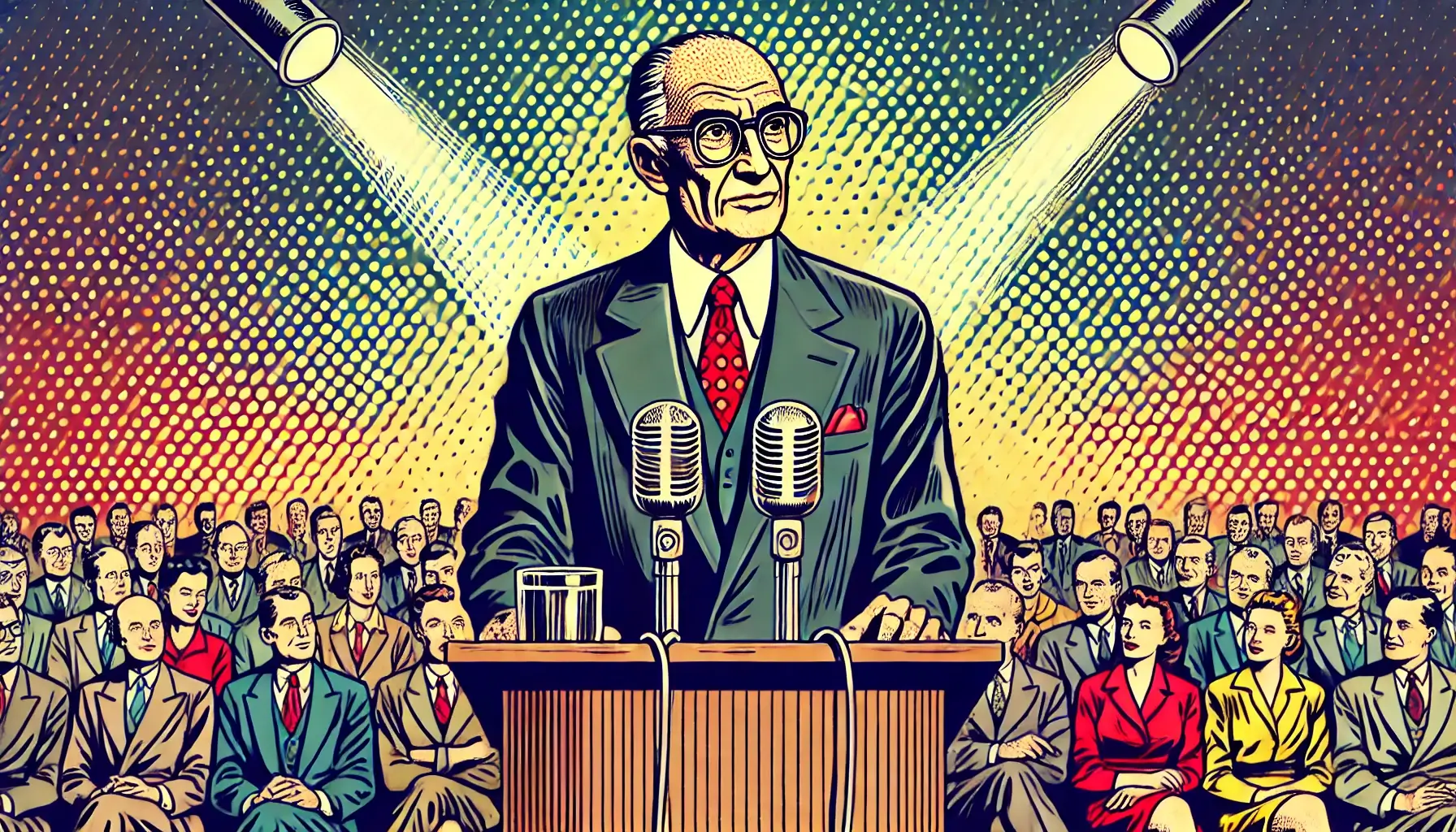The Marxist Paradox of Milton Friedman

The Marxist Paradox of American economics can be traced back to Milton Friedman. Milton Friedman is regarded as one of the most influential economists of the 20th century, celebrated for his contributions to free-market thinking and monetary policy. Yet beneath the veneer of his economic philosophy lies a series of contradictions, oversimplifications, and outright missteps that continue to plague both academia and policy-making. Ironically, while Friedman sought to champion capitalism, many of his ideas laid the groundwork for a system that, in practice, resembles the very Marxist philosophies he sought to oppose. This is the Marxist paradox of Milton Friedman: a man lionized as the father of modern capitalism unwittingly promoted principles that turned America’s economy into a quasi-Marxist framework, dominated by elite control and systemic inequality.
The Productivity Fallacy: A Marxist Approach in Disguise
At the core of Friedman’s economic thought is a profound misalignment of the concept of productivity. Rather than linking productivity to revenue and profit—the lifeblood of a healthy business—Friedman fixated on input costs and wages as the primary drivers. He also unequivocally, and repeatedly, claimed that the only source of inflation is the government. This emphasis on controlling the means of production and distribution (of capital), rather than fostering genuine economic growth, ironically mirrors Marxist economic theory. Not only does it use a Marxist framework, it directs activity to perpetuate this flaw.
By reducing productivity to a cost problem, Friedman elevated the suppression of wages and input costs over the creation of value. This framework does not incentivize innovation or competition; instead, it entrenches a system where elites hoard profits while workers bear the brunt of economic adjustments. In practice, this philosophy has transformed productivity into a tool of control rather than a measure of economic health. The result is a pseudo-Marxist academic framework that perpetuates inequality while being championed as capitalist orthodoxy.
Inflation Is Global: Friedman’s Myopic Nationalism
Friedman vehemently argued that inflation is not an international phenomenon but a national one. While it’s true that inflation is measured within national borders, the global interconnectedness of economies—especially in today’s world—renders this assertion fundamentally flawed. Even in Friedman’s time, the idea that inflation could be contained within a single country ignored the influence of international trade, financial markets, and geopolitical dynamics.
A recent example which explains the phenomenon of the interconnectedness of global economies is the Yen Carry Trade. This phenomenon involves American investors borrowing foreign currencies (in this case Japanese Yen) at lower interest rates than USD, and then investing that capital. Whether or not this practice is good is not the point. The point is that when inflation in one nation runs rampant, it impacts global trade.
Furthermore, the 1920s and the Great Depression provide a stark example of this fallacy. Entities like the Phoebus Cartel, which included domestic players like GE and foreign firms like Philips, manipulated markets across borders, inflating asset values and ultimately contributing to the collapse. This kind of cross-border collusion demonstrates that inflation and economic instability are inherently global phenomena. Today, the U.S.’s attempts to exert imperial control over global markets to manage domestic inflation only underscore how interconnected these systems have become—a reality Friedman’s framework fails to address.
Reevaluating Friedman’s Misreading of History
Friedman’s analysis of the Great Depression is another area where his economic philosophy falters. He largely attributes the economic collapse to poor monetary policy, ignoring the systemic market manipulation that inflated asset values and set the stage for the crash. During the 1920s, the stock market was effectively a rigged game, dominated by anticompetitive practices like “painting the tape,” where entities such as the Phoebus Cartel artificially drove up share prices.
Once common people invested in the stock market, to provide the liquidity which had dried up from institutions, the entire society was organized around a Marxist nightmare.
This manipulation created a bubble that inevitably burst, triggering bank runs, cash shortages, and an economic freefall. Friedman’s failure to address the role of these anticompetitive practices in creating the Depression reveals a fundamental blind spot in his understanding of economic crises. By focusing narrowly on monetary policy, he overlooked the structural weaknesses and systemic exploitation that caused the crash.
Soft Landings Are Only For The Rich
Friedman emphasized the need for an “adjustment period” during deflationary times, what we might now call a “soft landing.” But who benefits from such gradual transitions? The super-rich, who can reposition their wealth, exploit legal loopholes, and lobby for favorable policies while the poor endure economic pain. This approach protects elite interests while leaving ordinary people to suffer. It is presented to the public as a time of easing economic pain, but it actually exacerbates it for most people.
In reality, a rapid, controlled deflation would do more to rebalance the economy and level the playing field. The rich oppose this because it would strip them of their artificial advantages, creating a fairer competitive landscape. Friedman’s soft-landing philosophy is not about economic health; it’s about preserving the dominance of the wealthy. That again, is a Marxist paradigm that few comprehend or appreciate in full.
Inflation Has Become An Addiction: The Gluttony of a Nation
Friedman likened inflation to drinking: good effects first, bad effects later. While this metaphor works on a superficial level, it fails to capture the full reality of inflation. An alcoholic can hit rock bottom and eventually stop drinking. But inflation mongers never stop, and the tradition of endless inflation has persisted since the creation of the central bank, the end of the gold standard, and now the rise of cryptocurrency.
A more fitting metaphor is gluttony. Just as a glutton consumes too much sugar and develops diabetes—a condition that often becomes irreversible—an economy addicted to money printing becomes structurally unsound. America today resembles a donut shop, exporting sweet, printed cash while neglecting the balanced “food pyramid” of a healthy economy. This path leads to systemic instability and eventual collapse, a reality Friedman’s simplistic metaphor fails to address.
The Stock Market As A Prehistoric Cryptocurrency
The 1920s stock market, manipulated by entities like the Phoebus Cartel, serves as an early example of artificial value creation. This artificial value creation is often confused for actual capital production. Shares get inflated and sold at prices detached from their real value, much like today’s bubbles. These manipulations weren’t just speculative excess; they were systemic schemes designed to extract wealth from the many and consolidate it among the few.
The stock market’s role as a capital-production machine—detached from real value—continues to plague the economy. Friedman’s failure to address this dynamic allows modern markets to function as little more than legalized Ponzi schemes, perpetuating inequality and economic instability.
A Semi-Foreign Attack on America’s Financial System
The role of foreign influence in the Great Depression further undermines Friedman’s framework. Entities like the Phoebus Cartel used cross-border collusion to manipulate U.S. markets, exploiting vulnerabilities in the financial system. This was not just economic opportunism; it was an early form of economic warfare that destabilized the U.S. economy while enriching foreign and domestic elites.
The government’s response—socialization and massive public spending—was an attempt to stabilize a system fundamentally broken by these manipulations. For example, after the “Great Financial Crisis” the federal government essentially socialized many banks and automakers. Eventually they were bought out of that scheme, but the effects are still felt. We’ve never fully recovered from the systemic imbalances created during this period. Friedman’s failure to address those dynamics leaves his analysis incomplete and misleading. Those who follow his writing and speeches blindly have never considered these things or wilfully ignored them for their own benefit.
The Cost of Friedman’s Orthodoxy Cannot Be Overstated
Friedman’s ideas have dominated economic thought for decades, but their flaws are too significant to ignore. His demonization of productivity, misunderstanding of inflation’s global nature, and protection of elite interests during deflationary periods have entrenched systemic inequality. Worse, his oversimplified metaphors obscure the deeper structural issues threatening the American economy.
The Marxist paradox of Milton Friedman lies in his unintentional creation of a pseudo-Marxist framework, where elites control the means of production and distribution (especially of capital and value creation) while suppressing genuine competition. This is not the capitalism he claimed to champion—it’s a distorted system that perpetuates inequality and systemic instability.
To move forward, we must reject Friedman’s orthodoxy and embrace a balanced, sustainable approach to economics—one that prioritizes genuine productivity, fair competition, and the long-term health of the nation. Anything less will leave us trapped in the flawed framework Friedman left behind, on the brink of collapse.
